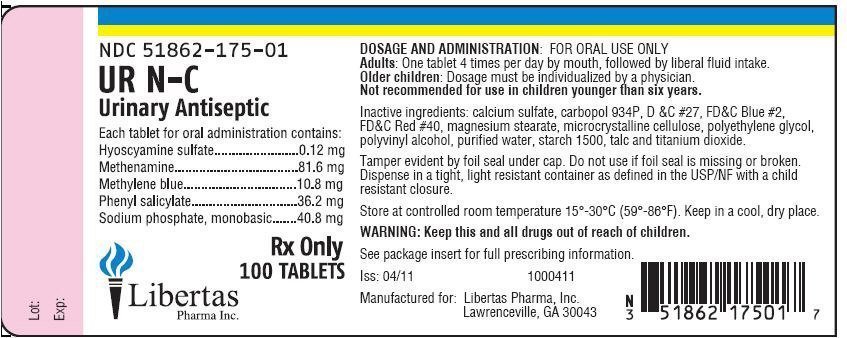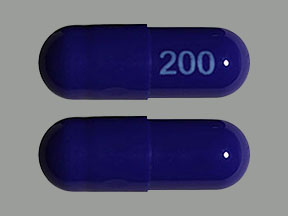UR N-C Urinary Antiseptic: Package Insert / Prescribing Info
Package insert / product label
Generic name: hyoscyamine sulfate, methenamine, phenyl salicylate, sodium phosphate monobasic, methylene blue
Dosage form: tablet
Drug class: Urinary antispasmodics
Medically reviewed by Drugs.com. Last updated on Mar 25, 2024.
On This Page
| Each tablet for oral administration contains: | |
| Hyoscyamine sulfate | 0.12 mg |
| Methenamine | 81.6 mg |
| Methylene blue | 10.8 mg |
| Phenyl salicylate | 36.2 mg |
| Sodium phosphate, monobasic | 40.8 mg |
Inactive ingredients: calcium sulfate, carbopol 934P, D &C #27, FD &C Blue #2, FD& C Red #40, magnesium stearate, microcrystalline cellulose, polyethylene glycol, polyvinyl alcohol, purified water, starch 1500, talc and titanium dioxide.
Hyoscyamine sulfate. [620-61-1] [3(S)-endo]-α-(Hydroxymethyl)-benzeneacetic acid 8-methyl-8-azabicyclo[3.2.1]oct-3-yl ester sulfate(2:1)(salt); 1αH,5α H-tropan-3α-ol(-)-tropate (ester) sulfate(2:1)(salt); 3α-tropanyl S-(-)-tropate; I-tropic acid ester with tropine; I-tropine tropate. C34H48N2O10S. Hyoscyamine sulfate is an alkaloid of belladonna. Exists as a white crystalline powder. Its solutions are alkaline to litmus. Affected by light, it is slightly soluble in water; freely soluble in alcohol; sparingly soluble in ether.
Methenamine. [100-97-0] 1,3,5,7- Tetraazatricyclo [3.3.1.13•7] decane; hexamethylenetetramine; HMT; HMTA; hexamine; 1,3,5,7- tetraazaadamantane hexamethylenemine; Uritone; Urotropin. C6H12N4; mol wt 140.19; C 51.40%, H 8.63%, N 39.96%. Methenamine (hexamethylenetetramine)exists as colorless, lustrous crystals or white crystalline powder. Its solutions are alkaline to litmus. Freely soluble in water, soluble in alcohol and in chloroform.
Phenyl salicylate. [118-55-8] 2-Hydroxybenzoic acid phenyl ester; Salol. C13H10O3 ; mol wt 214.22, C 72.89%, H 4.71%, O 22.41%. Made by the action of phosphorus oxy-chloride on a mixture of phenol and salicylic acid. Phenyl salicylate exists as white crystals with a melting point of 41°-43° C. It is very slightly soluble in water and freely soluble in alcohol.
Sodium phosphate, monobasic. [7558-80-7] Phosphoric acid sodium salt (1:1); Sodium biphosphate; sodium dihydrogen phosphate; acid sodium phosphate; monosodium orthophosphate; primary sodium phosphate; [H2NaO4P:] mol wt 119.98, H 1.68%, Na 19.16%, O 53.34%, P 25.82%. Monohydrate, white, odorless slightly deliquesce crystals or granules. At 100°C loses all its water; when ignited it converts to metaphosphate. It is freely soluble in water and practically insoluble in alcohol. The aqueous solution is acid. pH of 0.1 molar aqueous solution at 25°C: 4.5.
Methylene blue. [61-73-4] 3,7-Bis(dimethylamino) phenothiazin-5-ium chloride; C.I. Basic Blue 9; methylthioninium chloride; tetramethylthionine chloride; 3,7-bis(dimethylamino) phenazathionium chloride. C16H18CIN3S; mol wt 319.85, C 60.08%, H 5.67%, Cl 11.08%, N 13.14%, S 10.03%. Methylene blue (Methylthionine chloride) exists as dark green crystals. It is soluble in water and in chloroform; sparingly soluble in alcohol.
Indications and Usage for UR N-C Urinary Antiseptic
UR N-C is indicated for the treatment of symptoms of irritative voiding. Indicated for the relief of local symptoms, such as inflammation, hypermotility, and pain, which accompany lower urinary tract infections. Indicated for the relief of urinary tract symptoms caused by diagnostic procedures.
UR N-C Urinary Antiseptic Dosage and Administration
FOR ORAL USE ONLY
Adults: One tablet 4 times per day by mouth, followed by liberal fluid intake. Older Children: Dosage must be individualized by physician. Not recommended for use in children younger than six years.
Contraindications
UR N-C is contraindicated in patients hypersensitive to any of its ingredients. Risk benefits should be carefully considered when the following medical problems exist: achalasia of esophagus, atony of colon, diseases of cardiovascular system, gastrointestinal hemorrhage; glaucoma; hemolytic anemia from pyruvate kinase and G6PD deficiencies, infected urolithiasis, myasthenia gravis, paralytic ileus, severe ulcerative colitis, toxic megacolon; acute urinary retention may be precipitated in obstructive uropathy (such as bladder neck obstruction due to prostatic hypertrophy).
Warnings and Precautions
Do not exceed recommended dosage. This drug may make you dizzy or drowsy or cause blurred vision; use caution while driving, using machinery, or doing any activity that requires alertness or clear vision. Limit alcohol consumption. Cross sensitivity and/or related problems – patients intolerant of belladonna alkaloids or salicylates may be intolerant of this medication also. Delay in gastric emptying could complicate the management of gastric ulcers. There have been no studies to establish the safety of prolonged use of this product in humans. No known long-term animal studies have been performed to evaluate carcinogenic potential.
Pregnancy: Teratogenic Effects. Pregnancy Category C:
Hyoscyamine sulfate and methenamine cross the placenta. Studies have not been done in animals or humans. It is not known whether UR N-C tablets cause fetal harm when administered to a pregnant woman or can affect reproduction capacity. UR N-C tablets should be given to a pregnant woman only if clearly needed.
Nursing Mothers:
Problems in humans have not been documented; however, methenamine and traces of hyoscyamine sulfate are excreted in breast milk. Accordingly, UR N-C tablets should be given to a lactating woman only if clearly needed. Discuss the risks and benefits with your doctor.
Pediatric Use:
Infants and young children are especially susceptible to the toxic effect of the belladonna alkaloids (hyoscyamine sulfate). This product contains salicylate, which is related to aspirin. Children and teenagers should not take aspirin, aspirin-containing or aspirin-related medications if they have chickenpox, influenza, or any undiagnosed illness without first consulting a doctor. A rare but serious illness known as Reye's syndrome may occur. This medication is not recommended for children younger than 6 years.
Adverse Reactions/Side Effects
Cardiovascular: rapid heartbeat, flushing Central Nervous System: blurred vision, dizziness, drowsiness Genitourinary: difficulty micturition, acute urinary retention Gastrointestinal: dry mouth, nausea and vomiting Respiratory: shortness of breath or trouble breathing
Serious allergic reactions to this drug are rare. Seek immediate medical attention if you notice symptoms of a serious allergic reaction, including itching, rash, severe dizziness, swelling or trouble breathing.
This medication can cause urine and sometimes stools to turn blue-green. This effect is harmless and will subside after medication is stopped.
Call your doctor or physician for medical advice about side effects. The following number does not provide medical advice, but in the U.S. you may report suspected side effects to the FDA at 1-800-FDA-1088 or www.fda.gov/medwatch.
Drug Interactions
This drug should not be used with the following medications because very serious interactions may occur: live influenza virus vaccine, pramlintide. Because of this product's effect on gastrointestinal motility and gastric emptying, it may decrease the absorption of other oral medications during concurrent use such as: urinary alkalizers; thiazide diuretics (may cause the urine to become alkaline reducing the effectiveness of methenamine by inhibiting its conversion to formaldehyde); antimuscarinics (concurrent use may intensify antimuscarinic effects of hyoscyamine sulfate because of secondary antimuscarinic activities of these medications); antacids/antidiarrheals (may reduce absorption of hyoscyamine sulfate, concurrent use with antacids may cause urine to become alkaline, reducing effectiveness of methenamine by inhibiting its conversion to formaldehyde). Doses of these medications should be spaced 1 hour apart from doses of hyoscyamine sulfate; antimyasthenics (concurrent use with hyoscyamine sulfate may further reduce intestinal motility); ketoconazole (patients should be advised to take this combination at least 2 hours after ketoconazole); monoamine oxidase (MAO) inhibitors (concurrent use may intensify antimuscarinic side effects), opioid (narcotic analgesics may result in increased risk of severe constipation); sulfonamides (these drugs may precipitate with formaldehyde in the urine, increasing the danger of crystalluria). This is not a complete list of all drug interactions. Tell your doctor or pharmacist of all prescription medications prior to use.
Drug Abuse and Dependence
A dependence on the use of UR N-C has not been reported nor expected based on the pharmacology of the ingredients contained in UR N-C.
Overdosage
By exceeding the recommended dosage of UR N-C, symptomology related to the overdose of its individual active ingredients may be expected as follows:
Hyoscyamine sulfate: Symptoms associated with overdosage of UR N-C will most probably be manifested in the symptoms related to overdosage of alkaloid hyoscyamine sulfate. Such symptoms as dryness of mucous membranes; dilation of pupils, hot, dry, flushed skin; hyperpyrexia; tachycardia; palpitations; elevated blood pressure; coma; circulatory collapse and death from respiratory failure can occur due to overdosage of these alkaloids.
Methenamine: If large amounts of the drug (2-8 g daily) are used over extended periods (3-4 weeks), bladder and gastrointestinal irritation, painful and frequent micturition, albuminuria and gross hematuria may be expected.
Phenyl salicylate: Symptoms of phenyl salicylate overdosage include burning pain in throat and mouth, white necrotic lesions in the mouth, abdominal pain, vomiting, bloody diarrhea, pallor, sweating, weakness, headache, dizziness and tinnitus. The symptoms, however, are not expected to be discernible from those associated with the other active ingredients in UR N-C.
Sodium phosphate, monobasic: Symptoms of sodium biphosphate overdosage may include diarrhea, dehydration, and electrolyte imbalances.
Methylene blue: Symptoms of methylene blue overdosage associated with the overdosage of UR N-C are not expected to be discernible from those associated with other active ingredients in UR N-C.
Treatment: Emesis or gastric lavage. Slow intravenous administration of physostigmine in doses of 1 to 4 mg (0.5 to 1 mg in children), repeated as needed in one to two hours to reverse severe antimuscarinic symptoms. Administration of small doses of diazepam or baclofen to control excitement and seizures. Artificial respiration with oxygen if needed for respiratory depression. Adequate re-hydration is required. Symptomatic treatment as determined by a doctor.
If overdose is suspected, contact your local poison center or emergency room immediately. US residents can contact the US National Poison Hotline at 1-800-222-1222.
UR N-C Urinary Antiseptic - Clinical Pharmacology
Hyoscyamine sulfate: Hyoscyamine sulfate is a parasympatholytic which relaxes smooth muscles and thus produces an antispasmodic effect. It is well absorbed from the gastrointestinal tract and is rapidly distributed throughout the body tissues. Following oral administration, the drug has an onset of action of 20 to 30 minutes. The half-life is 3.5 hours. Hyoscyamine is distributed throughout the body, crosses the blood-brain barrier, and is approximately 50% bound to plasma proteins. It is metabolized in the liver to tropic acid, tropine, and hyoscyamine glucuronide. Hyoscyamine is excreted primarily unchanged in the urine within 12 hours. Its biotransformation is hepatic.
Methenamine: Methenamine, after oral administration, undergoes hydrolysis and generates formaldehyde, which provides bactericidal or bacteriostatic action. Methenamine is rapidly absorbed from the intestinal tract and is excreted, for the most part, unchanged in the urine at which point it is hydrolyzed if the urine is acidic. It is almost completely excreted (90%) in the urine within 24 hours; of this at a pH of 5, approximately 10-30% is converted to formaldehyde in the stomach.
Phenyl salicylate: Phenyl salicylate, a form of salicylic acid, is a mild analgesic for pain relief.
Sodium phosphate, monobasic: Sodium phosphate, monobasic increases urinary acidity helping to maintain an acid pH necessary for the degradation of methenamine.
Methylene blue: Methylene blue is a monoamine oxidase inhibitor with weak antiseptic properties. It is well absorbed by the intestinal tract and rapidly reduced to leukomethylene blue, which is stabilized in the urine. Approximately 70-80% is excreted unchanged in the urine.
How is UR N-C Urinary Antiseptic supplied
UR N-C is available as a purple tablet, imprinted "293": bottles of 100 tablets, NDC 51862-175-01. Dispense in a tight, light-resistant container as defined in the USP/NF with a child resistant closure. Store at controlled room temperature 15°-30°C (59°- 86°F). Keep in a cool, dry place.
WARNING: Keep this and all drugs out of reach of children. Caution: Rx Only
Manufactured for:
Libertas Pharma, Inc.
Lawrenceville, GA 30043
Iss. 04/11 175-01
1000412
| UR N-C URINARY ANTISEPTIC
hyoscyamine sulfate, methenamine, phenyl salicylate, sodium phosphate monobasic, methylene blue tablet |
||||||||||||||||||||||||||||||
|
||||||||||||||||||||||||||||||
|
||||||||||||||||||||||||||||||
|
||||||||||||||||||||||||||||||
|
||||||||||||||||||||||||||||||
|
||||||||||||||||||||||||||||||
|
||||||||||||||||||||||||||||||
| Labeler - Mayne Pharma Inc. (867220261) |
More about hyoscyamine / methenamine / methylene blue / phenyl salicylate / sodium biphosphate
- Check interactions
- Compare alternatives
- Reviews (43)
- Side effects
- Drug class: urinary antispasmodics
- En español
Patient resources
- Hyoscyamine, methenamine, methylene blue, phenyl salicylate, sodium biphosphate drug information
- Hyoscyamine, methenamine, methylene blue, phenyl salicylate, and sodium phosphate (Advanced Reading)
Professional resources
Other brands
Uribel, Uretron DS, Urelle, Phosphasal, ... +7 more


